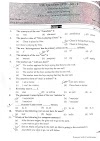Rutherford’s atomic model
Alpha ray
• Mechanical wave
• 2 +ve charge
• 2 protons + 2 neutrons
Radioactive substance (Radium)
Lead cavity
Gold foil ( Thickness = 0.00004cm)
ZnS Screen ( Alpha particle shines in ZnS screen)
Nucleus ( As a Result)
i) Outer hollow part – orbital or shell
ii) Central dense part – Nucleus
• 1 Fermi = 10^-15 m
i) Does not explain continuous spectrum or H- spectrum
ii) The moving charge particle electron does not loss the energy (Does not follow law of electro dynamics)
Bohr’s atomic model
Stationary State: Energy neither loss nor gain when electron revolves round the nucleus is called stationary state.
Quantization of angular momentum:
(Angular Momentum)
Principle quantum no.
Formation of spectra: When we give energy externally, it jumps to the upper energy level and when it jumps to lower energy level, it emits energy in the form of spectra.
(where Plank’s constant and frequency)
Similarly,
or
i) Lyman Series:
• UV rays
• and
ii) Balmer Series:
• Visible region = observe photochemical Reaction
= VIBGYOR
• and
iii) Paschen Series:
• IR
• and
iv) Brackett Series:
• IR
• and
v) Pfund Series:
• IR
• and
: (Worth to remember)
Total no of spectral lines
No of spectral lines in between two given series
Balmer’s Formula
Where Rydberg’s constant
Defects of Bohr’s atomic model:
i) It does not explain the micro or fine spectrum
ii) It does not explain the spectrum of multi electron system but only explain the spectrum of mono electron system like , , , etc.
iii) It does not explain the Zeeman effect (splitting of lines due to magnetic field), Stark effect ( Splitting of lines due to electric field) and Shielding effect.
iv) It does not explain the duel nature of electron
Quantum Number
The state and nature of electron in orbit.
Orbit Number Orbit Designation Principal Quantum Number(n) Max. Number of Electrons in the orbit() 1 K 1 2 2 L 2 8 3 M 3 18 4 N 4 32 5 O 5 - 6 P 6 - Main shell or main orbit or main axis
Represented by n
It determines the size of atom
Total no. of electron in each orbit
Total no. of orbital in each orbit
Eg : L = 2s (s) , 2p ( px, py, pz)
Also, radius
Energy
Sub shell or subsidiary or auxillary quantum number
Represented by ‘l’
{1 less than principle quantum no.}
Eg: For K shell
s-sub shell
For M shell
Maximum no of electron in each subshell
or
(Sperical)
(Dumbell)
(Double dumbbell)
( Complicated )
Azimuthal quantum number determines the shape of orbital.
Orbital angular momentum
Degenerated orbitals of each subshell.
Orientation of orbitals in Zeeman effect
Splitting of orbitals
Represented by ‘m’
Calculated by
M ranges from to including zero
i.e.
Eg: For d sub shell:
no of orbitals of d-sub shell
The state and nature of electron in orbital
Represented by ‘s’
Spin angular momentum
Values are and
Remember
No two electrons in an atom can have the same set of all quantum no.
Eg: Presence of Pauli’s exclusion principle
Absence of Pauli’s Exclusion principle (Mistake)
or Simon’s (n+l) rule:
an electron occupies orbitals in order from lowest energy to highest.
rule
NOTE:
a)
because for
For
b)
Because
In this case electron must be filled in subshell with less principle quantum number.
Electrons are filled in degenerated orbitals of each subshell at 1st single and then paired from lower energy level to higher energy level.
Half filled and full filled orbitals are more stable
Eg : why? => (Half filled) Trigonal Planar
The compound of Zinc is always white because zinc has no unpaired electrons.
is more stable than in solid state.
is more stable than in solution state.
is more stable than in both solid and liquid state




![[UPDATED] New Syllabus of IOE Entrance Examination |](https://blogger.googleusercontent.com/img/b/R29vZ2xl/AVvXsEj5C60n4l8guBTBqS4sBFaD1z9AoLPnKFQB_f1-F731bzrW_xcCsoewcBcUtqnpJhlf7lL5sOklAtsxRKdgZ-dCQiAgQb1T2X9ck-D_FYoU01fPdPA0mbsulZgmnkS-6-3Hg_CbxBExwn3z5c3-8srStMoZwr6SrmsgF5fPGjnD29T_lg1XsX3aZoIQm9k/w680/pic.png)


![[UPDATED] New Syllabus of IOE Entrance Examination |](https://blogger.googleusercontent.com/img/b/R29vZ2xl/AVvXsEj5C60n4l8guBTBqS4sBFaD1z9AoLPnKFQB_f1-F731bzrW_xcCsoewcBcUtqnpJhlf7lL5sOklAtsxRKdgZ-dCQiAgQb1T2X9ck-D_FYoU01fPdPA0mbsulZgmnkS-6-3Hg_CbxBExwn3z5c3-8srStMoZwr6SrmsgF5fPGjnD29T_lg1XsX3aZoIQm9k/w100/pic.png)

0 Comments